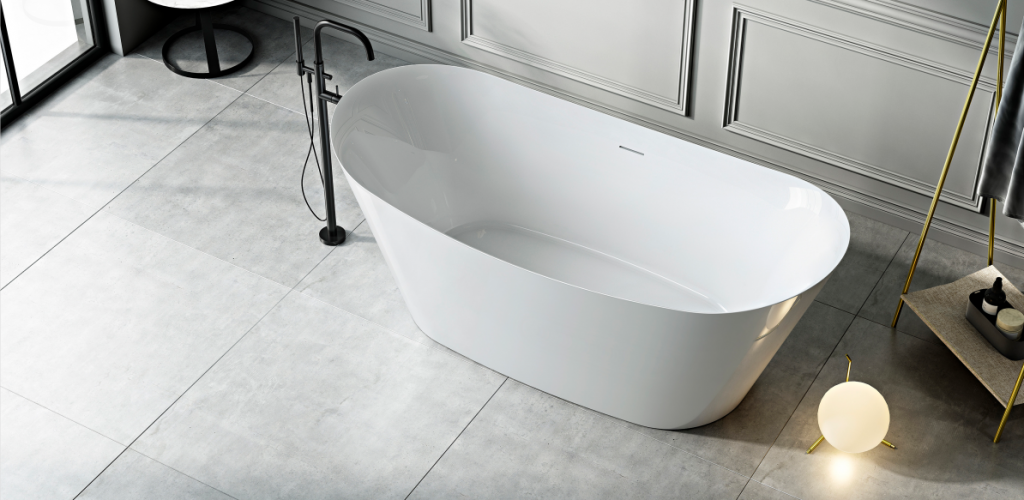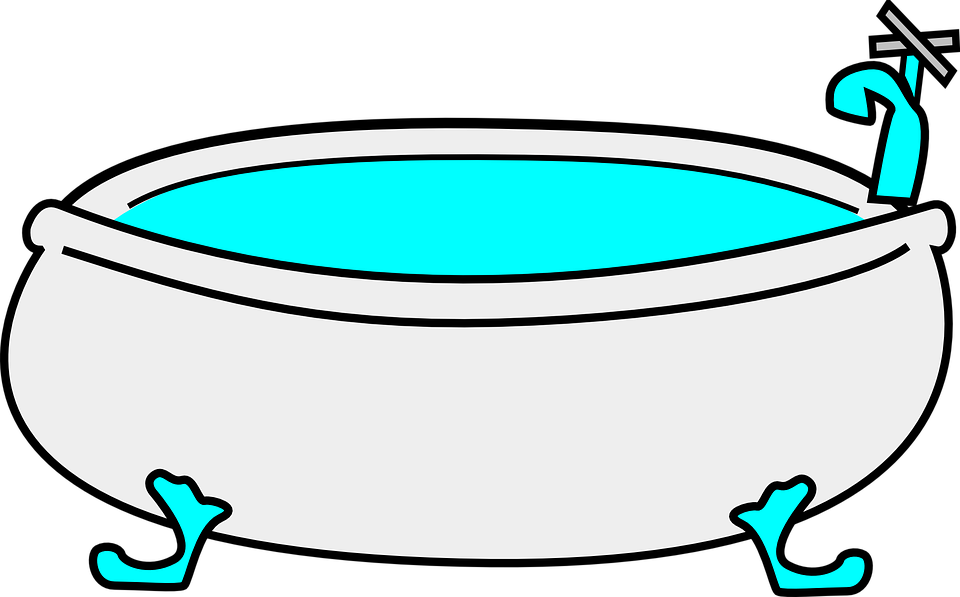What is a modern freestanding tubs? What are the advantages of a freestanding bathtub?
With the improvement of the quality of life, many owners have begun to install a bathtub at home. Many star-rated hotels are also equipped with bathtubs. There are more and more types of bathtubs on the market. One of them is called a modern freestanding tubs, which is similar to a freestanding bathtub. Compared with other types of bathtubs, it is more convenient to use. So what is a freestanding bathtub? What are the advantages of a freestanding bathtub? Lets find out with me.

What is a freestanding bathtub?
1. The freestanding bathtub is freestanding, it can be placed directly in the bathroom. The freestanding bathtub can be placed in the space as long as it can be placed. The modern freestanding tubs of Ciler can be customized in any size.
2. A freestanding bathtub is a bathtub that is placed directly on the bathroom floor, and the inside and outside are smooth and clean, and there is no need to lean against the wall just place it independently in the bathroom. This method is convenient for construction and easy to overhaul, and is suitable for selection when the ground has been decorated.
What are the advantages of a freestanding bathtub?
1. The modern freestanding tubs does not need a masonry or even a skirt. Its unique effect is sought after by avant-garde hipsters. Therefore, the price is naturally high in the market. However, the comfort and freedom brought by the modern freestanding tubs is something that ordinary bathing cannot give. In a broad sense, as long as the bathtub is separated from other items, it can be called a freestanding bathtub. Many Jacuzzis also fall under its category.
2. Freestanding bathtubs are available in a variety of styles and materials, including a series of materials such as acrylic and stone. According to different styles of bathrooms, different materials can be used to make freestanding bathtubs. For example, this freestanding bathtub made of acrylic material in the picture matches the white wall just right.
3. The side of the non-free-standing bathtub against the wall is very difficult to clean, but the modern freestanding tubs can be cleaned very well, and it can be cleaned at will at 360 degrees, so there is no gap between the free-standing bathtub and the wall. Maintenance is simplified.
4. The existence of a freestanding bathtub has its “harshness”. It has high requirements for the bathroom area, its own installation, and the coordination with the surrounding environment. It can drive away the fatigue of the day and bring people comfortable and luxurious enjoyment. Its own excellent quality, unique posture, and inheritability are irresistible charms. Choosing it is not just a simple bathing tool, but a bathing culture. Its existence is not just to provide people with a space to bathe, it will become more attractive with the passage of time.

Comparison of the advantages and disadvantages of common material modern freestanding tubs .The materials of the bathtub are:
1. Acrylic bathtub, with more colors, styles and shapes, and higher finish;
2. Cast iron bathtub, good thermal insulation performance, easy to clean, and no excessive noise when water is discharged;
3. Wooden bathtub, no It will generate static electricity, has good anti-corrosion performance, and is environmentally friendly material;
4. Steel bathtub has good pressure resistance, wear resistance and heat resistance, and is durable;
5. Ceramic bathtub, smooth and delicate surface, easy to clean and various styles .
Acrylic bathtub
Advantages: bathtubs made of acrylic materials are relatively common in the market. Acrylic modern freestanding tubs materials are soft and easy to process. They have very rich shapes and colors. Consumers have more choices and can pursue individuality. Acrylic bathtubs have a high thermal insulation effect. , It can keep warm for a long time in winter. Lightweight, easy to transport and install. Scratches on the surface can be repaired.
Siller Sanitary Ware specializes in the research, development, production and sales of acrylic bathtubs. It has been well received by domestic and foreign customers.
Disadvantage: The surface is easily scratched.
2. Cast iron bathtub
Advantages: Cheaper, lightweight and easy to install.
Disadvantages: Due to the production process and material, the steel bathtub has a monotonous shape and a single color, so there are not many types to choose from in terms of styles and types. The thermal insulation effect is poor, the noise of water injection in the bathtub is large, and the overall process of the cast iron is relatively complicated. If the enamel layer on the surface is subjected to excessive impact during transportation and use, the glaze will explode, resulting in the formation of the cylinder. rusted and unusable.
3. Ceramic bathtub
Advantages: The ceramic modern freestanding tubs is made of ceramic china clay, and the appearance of the glaze is high. Its surface is smooth and delicate, easy to clean and has a variety of styles, so it is very popular among people, but when choosing a bathtub made of ceramic material, we must pay attention to the glaze construction process on the surface, consider the water absorption expansion rate of the surface, and the general water absorption expansion rate. Smaller products can be counted as superior bathtub products.
Disadvantages: heavy and difficult to transport, afraid of bumps, smooth and easy to slip, cracks and scratches cannot be repaired
4. Wooden bathtub
Advantages: It is more environmentally friendly, has strong thermal insulation, and the cylinder body is deep, which can completely soak every part of the body. The bathtub made of wooden materials will not generate static electricity, and it is more environmentally friendly and healthy to use.
Disadvantages: The price is high, maintenance is usually required, and it cannot be exposed to the sun for a long time, or in a humid environment for a long time to prevent water leakage and deformation.
5. Steel bathtub
Advantages: Durability is the biggest advantage of cast iron bathtubs. In addition, it has a mild color, low water injection noise and easy cleaning.
Disadvantages: Due to the high production cost, the price of cast iron bathtubs is generally high, the shape is relatively monotonous, there are not many color choices, and the heat preservation is average. Due to the material, the weight is heavy, and it is not easy to install and transport.
The above are the different characteristics of common material bathtubs. Buyers can choose the modern freestanding tubs that suits them according to their needs and preferences.

Analysis of the status and development prospects of the bathtub industry in 2022
Modern freestanding tubs industry are usually installed in home bathrooms, hotels, bathroom devices for bathing or showering, and are mostly made of acrylic or fiberglass. According to different functions, bathtubs can be divided into ordinary bathtubs, seat bubble bathtubs, and massage bathtubs. The price of various types of modern freestanding tubs varies greatly. According to the different materials used in the bathtub, bathtubs can be divided into acrylic bathtubs, cast iron bathtubs, steel enamel bathtubs, and wooden bathtubs. Among them, acrylic bathtubs are the most common in the market, accounting for about 80% of the market. . With the growth of the global economy, the consumption of household bathroom products has been upgraded, and the global demand for bathtub products will continue to grow, especially the demand for high-end bathtubs will continue to grow.
In recent years, with the upgrading and development of consumption, consumers demand for bathtubs has continued to increase, and the modern freestanding tubs market has developed rapidly in other developing countries except developed countries. At the same time, the development of the high-end hotel industry has increased the demand for bathtub products. With the in-depth development of the sanitary ware industry, although sanitary ware in developed countries has received the highest attention, the market in developed countries is close to saturation, and the developing countries have great potential for it. The market potential has been widely concerned by major home furnishing companies, and the developing country market will become a new focus for sanitary ware companies to compete for the market.
The future competition battlefield of the modern freestanding tubs industry will shift to developing countries. It can be said that developing countries are the blue ocean market of the future sanitary ware. Regionally, the traditional developed regions are still very strong, but with the development of various countries around the world, the sanitary ware market has also quietly changed and a new pattern has emerged.

The origin of the bathtub?
The ancients used a wooden bucket for bathing, and there was also a “floor pot” that was heated while washing. Whether wooden barrels or “floor pots”, they are the predecessors of the modern freestanding tubs. The earliest bathtubs were made of wood lined with lead, followed by marble bathtubs. Since the 18th century, metal bathtubs have become popular. The most common material is red copper tinned. The biggest feature of this material is that it does not rust. The inside of the tub can be tinned or even silver-plated. There are also modern freestanding tubs with joinery that are veritable antique furniture, with backrests or upholstered, in the form of sofa chairs or benches, for single or double use. In the late 18th century, the famous wooden shoe bathtub also appeared, which was composed of more than 20 metal parts, named after the shape of a human shoe, with a watering funnel and a draining faucet. The comforts of the modern bathroom began in England in the 19th century, with the appearance of a modern freestanding tubs that could wash a wave bath, and eventually a closed shower. By the end of the century, the new material acrylic 、cast iron and so on appeared.
Bathing is a habit that has been around since the dawn of mankind. But in the early days, there was no concept of “bathroom”, let alone a bathtub. Natural streams and small rivers became public bathing areas for people. The birth of the first true bathtub can be traced back to 1700 BC. By the middle of the 19th century, the modern freestanding tubs gradually became popular. At this time, the bathtub already had a very obvious modern style. Nowadays, the modern freestanding tubs is no longer a symbol of social status, and has become a part of peoples lives with the development of the times.


